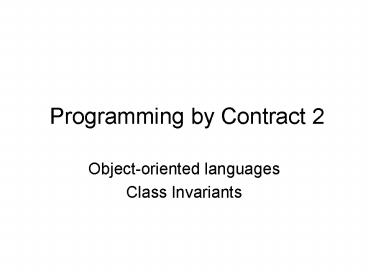Programming by Contract 2 - PowerPoint PPT Presentation
1 / 12
Title:
Programming by Contract 2
Description:
assert( top() == val ); assert( size() == origsize 1 ); Class Invariants ... A class invariant expresses consistency constraints that apply to all objects of ... – PowerPoint PPT presentation
Number of Views:23
Avg rating:3.0/5.0
Title: Programming by Contract 2
1
Programming by Contract 2
- Object-oriented languages
- Class Invariants
2
Object Lifecycle
Born
Dies
Lives
3
Client example
- From a client's viewpoint
- Stack s1 new Stack
- s1.push(new Integer(4))
- System.out.println(s1.pop())
- // can be collected now
4
Preconditions of methods
Constructor
Precondition depends upon current object state,
plus any inputs to the method.
5
Postconditions of methods
MethodA
MethodB
(Finalizer)
Constructor
state0
state1
state2
- Postcondition talks about the new state of the
object and the method's outputs. - May need to refer to initial states and inputs
for comparison.
6
Push Example
- public class Stack extends Vector
- public void push(Object val)
- assert(dataArray ! null)
- int origsize size() //save it.
- assert(origSize gt 0)
- // Push code . . .
- assert( ! empty() )
- assert( top() val )
- assert( size() origsize1 )
7
Class Invariants
- Pre/Postconditions only describe the properties
of individual methods. - We also want to document properties of the whole
class. Things which are common to its methods. - A class invariant expresses consistency
constraints that apply to all objects of that
class, all through their lifecycle.
8
When is class invariant true?
- Class Invariant is true.
9
Class Invariant Rules
- Constructors must establish C.Inv.
- Methods must maintain C.Inv.
- However, within the method, the class invariant
may be temporarily broken, while data structures
are being updated. - Finalizer can assume C.Inv.
- Subclasses should only strengthen C.Inv.
10
Checking Class Invariants
- Define an invariant method in each class.
- public/protected void invariant()
- Call it at the end of each constructor, and at
the end of each method that modifies the object. - (Challenge disable these calls in release
code?). - Advantages
- Clear documentation of class data structures.
- Catches corrupt data errors ASAP.
- Subclasses can refine invariant() adding their
own additional checks (strengthen).
11
Invariant() Example
- pubIic class Stack extends Vector
- protected void invariant()
- super.invariant()
- assert(0 lt size())
- assert(empty() (size()0))
- if (!empty())
- assert(top() elementAt(size()-1)
12
Program Inspection
- How many bugs in your new program?
- Standard ratio, say 100/1000 LOC?
- Debugging is a VERY slow way of removing them
(and only removes some obvious ones). - Inspection (Before debugging!)
- Read through code carefully.
- Think deeply about each line.
- "What could go wrong here?"
- "How do I know this is right?"
Coding
Debugging
Inspection































